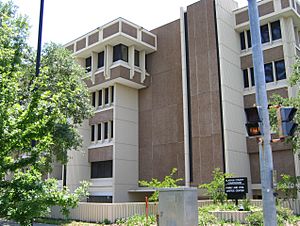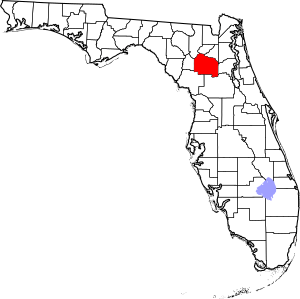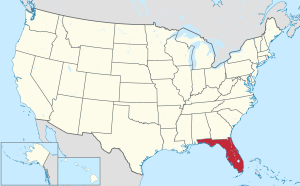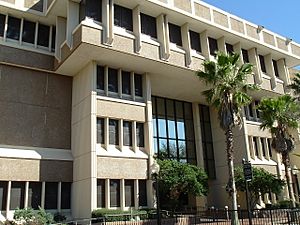Alachua County, Florida facts for kids
Quick facts for kids
Alachua County
|
|||
|---|---|---|---|

Alachua County Courthouse
|
|||
|
|||

Location within the U.S. state of Florida
|
|||
 Florida's location within the U.S. |
|||
| Country | |||
| State | |||
| Founded | December 29, 1824 | ||
| Named for | Alachua (Timucuan word for "sinkhole") | ||
| Seat | Gainesville | ||
| Largest city | Gainesville | ||
| Area | |||
| • Total | 969 sq mi (2,510 km2) | ||
| • Land | 875 sq mi (2,270 km2) | ||
| • Water | 94 sq mi (240 km2) 9.7%% | ||
| Population
(2020)
|
|||
| • Total | 278,468 |
||
| • Density | 290/sq mi (110/km2) | ||
| Time zone | UTC−5 (Eastern) | ||
| • Summer (DST) | UTC−4 (EDT) | ||
| Congressional district | 3rd | ||
Alachua County (pronounced ə-LATCH-oo-ə) is a county located in the north central part of Florida. It's a place with a rich history and a growing population. In 2020, about 278,468 people lived here. The main city and county seat is Gainesville, which is also home to the famous University of Florida.
Contents
History of Alachua County
Early People and Spanish Influence
The very first people to live in the Alachua County area were Paleo-Indians. They left behind tools and other items in the Santa Fe River basin over 10,000 years ago! Later, around 100 CE, people from the Deptford culture settled here. They developed a local group called the Cades Pond culture. Around 600 CE, the Alachua culture took over.
When the Spanish arrived in Florida in the 1500s, the Timucua-speaking Potano people lived in this area. They became part of the Spanish mission system. However, many Potano people died from diseases brought by the Europeans. Others were affected by rebellions and attacks from tribes supported by the English. Because of this, the area that is now Alachua County became mostly empty of people by the early 1700s.
In the 1600s, a Spanish official named Francisco Menéndez Márquez started a ranch called La Chua. It was on the north side of what is now Payne's Prairie. The word "Alachua" likely comes from a Timucua word for "sinkhole," as there are many sinkholes in the area.
The Seminoles and Early Conflicts
Around 1740, a group of Oconee people led by a chief named Ahaya, also known as "Cowkeeper," settled on Payne's Prairie. These Native American groups, mostly Muscogee (called "Creek" by the English), who moved into Florida became known as "Seminoles." Ahaya's group was called the Alachua Seminoles.
In 1774, a traveler named William Bartram visited Ahaya's town, Cuscowilla. Later, King Payne became the chief and started a new town called Payne's Town. In 1812, during a time when Americans tried to take over Spanish Florida, a group from Georgia fought with the Alachua Seminoles near Newnans Lake. King Payne was hurt and died later. The Alachua Seminoles then moved away.
Another American group attacked the area in 1813, burning Seminole villages. In 1814, some American settlers tried to create their own settlement near the old Payne's Town, but it failed after their leader was killed by Seminoles.
American Settlers Arrive
After Florida officially became part of the United States, more people from the U.S. and Europe started settling in the area. A place called Wanton's Store attracted settlers who founded Micanopy.
In 1823, the Treaty of Moultrie Creek made the Seminoles move to a reservation further south. This led to even more settlers coming into Alachua County. Many moved into former Seminole towns, like Hogtown.
How Alachua County Was Formed
Alachua County was officially created by the Florida government in 1824. At first, it was very large, stretching from the Georgia border all the way south to Charlotte Harbor. The first county seat was Wanton's (which later became Micanopy). In 1828, the county seat moved to Newnansville, near where the city of Alachua is today.
Over the years, Alachua County became smaller as new counties were created from its land. For example, Columbia County was formed in 1832, and Hillsborough County in 1834. In 1839, some land was returned to Alachua County, and Newnansville became the county seat again. More counties like Hernando, Marion, and Levy were created from Alachua County's original territory.
In 1854, a new railroad was built that went around Newnansville. A new town called Gainesville grew up along the railroad. Businesses and people started moving to Gainesville, and it became the new county seat that same year.
Geography of Alachua County
Alachua County covers about 969 square miles. Most of this area, 875 square miles, is land, and 94 square miles (about 9.7%) is water.
Counties Next to Alachua County
- Bradford County - north
- Union County - north
- Putnam County - east
- Marion County - southeast
- Levy County - southwest
- Gilchrist County - west
- Columbia County - northwest
People and Languages in Alachua County
| Historical population | |||
|---|---|---|---|
| Census | Pop. | %± | |
| 1830 | 2,204 | — | |
| 1840 | 2,282 | 3.5% | |
| 1850 | 2,524 | 10.6% | |
| 1860 | 8,232 | 226.1% | |
| 1870 | 17,328 | 110.5% | |
| 1880 | 16,462 | −5.0% | |
| 1890 | 22,934 | 39.3% | |
| 1900 | 32,245 | 40.6% | |
| 1910 | 34,305 | 6.4% | |
| 1920 | 31,689 | −7.6% | |
| 1930 | 34,365 | 8.4% | |
| 1940 | 38,607 | 12.3% | |
| 1950 | 57,026 | 47.7% | |
| 1960 | 74,074 | 29.9% | |
| 1970 | 104,764 | 41.4% | |
| 1980 | 151,348 | 44.5% | |
| 1990 | 181,596 | 20.0% | |
| 2000 | 217,955 | 20.0% | |
| 2010 | 247,336 | 13.5% | |
| 2020 | 278,468 | 12.6% | |
| 2023 (est.) | 285,994 | 15.6% | |
| U.S. Decennial Census 1790-1960 1900-1990 1990-2000 2010-2015 |
|||
In 2020, Alachua County had 278,468 people living in 101,979 households. About half of these households (50,803) were families.
| Race | Population 2020 | Percentage 2020 |
|---|---|---|
| White (Non-Hispanic) | 160,463 | 57.62% |
| Black or African American (Non-Hispanic) | 51,171 | 18.38% |
| Native American or Alaska Native (Non-Hispanic) | 562 | 0.2% |
| Asian (Non-Hispanic) | 17,891 | 6.42% |
| Pacific Islander (Non-Hispanic) | 101 | 0.04% |
| Some Other Race (Non-Hispanic) | 1,668 | 0.6% |
| Mixed/Multi-Racial (Non-Hispanic) | 12,998 | 4.67% |
| Hispanic or Latino | 33,614 | 12.07% |
| Total | 278,468 | 100.00% |
Of all households, 22.0% had children under 18. The average household had 2.32 people. The median age in the county was 30.1 years old. About 17.9% of the population was under 18, and 10.8% was 65 or older.
Languages Spoken
In 2010, most people (86.43%) in Alachua County spoke English as their main language. Other languages spoken included Spanish (6.38%), Chinese (1.18%), Korean (0.57%), and French (0.52%).

Education in Alachua County
The Alachua County School District manages 47 schools across the county. Alachua County is also home to two important colleges: the University of Florida and Santa Fe College.
Libraries in Alachua County
The Alachua County Library District provides public library services to about 250,000 people in the county. This includes all the cities and towns. The main library and four branches are in Gainesville. There are also branches in other towns like Alachua, Archer, Hawthorne, High Springs, Micanopy, Newberry, and Waldo. The library also has two bookmobiles that visit many locations each month.
History of Libraries in Alachua County
The library system started in 1905 when a group in Gainesville created a library where people paid a fee to borrow books. In 1918, the Gainesville Public Library became free for everyone, supported by city taxes. However, at that time, public places were segregated, so the library was only for white people.
In 1953, the Carver Branch Library opened, giving African Americans in the city access to a library. After the main library was desegregated (meaning everyone could use it) in 1969, the Carver Branch closed.
In 1958, Gainesville and Alachua County decided to run the library together. New branches opened in High Springs, Hawthorne, and Micanopy the next year, and a bookmobile started. The Alachua County Library District was officially created in 1986. More branches opened throughout the 1990s and 2000s, making library services available to even more people.
Transportation in Alachua County
Major Roads
 I-75
I-75 US 27
US 27 US 41
US 41 US 301
US 301 US 441
US 441 SR 20
SR 20 SR 24
SR 24 SR 26
SR 26 SR 121
SR 121 SR 331
SR 331
Airports
- Gainesville Regional Airport - Gainesville
- Flying Ten Airport - Archer
- Oak Tree Landing Airport - High Springs
- Gleim Field Airport - Gainesville
Communities in Alachua County
| # | Community Name | Type | Population |
|---|---|---|---|
| 2 | Alachua | City | 9,561 |
| 6 | Archer | Town | 1,158 |
| 1 | Gainesville | City | 128,460 |
| 5 | Hawthorne | City | 1,471 |
| 3 | High Springs | City | 5,672 |
| 9 | La Crosse | Town | 372 |
| 8 | Micanopy | Town | 622 |
| 4 | Newberry | City | 5,412 |
| 7 | Waldo | City | 1,024 |
Other Communities (Unincorporated)
- Campville
- Cross Creek
- Evinston
- Fairbanks
- Grove Park
- Hague
- Haile
- Haile Plantation
- Island Grove
- Jonesville
- Melrose
- Rochelle
- Santa Fe
- Windsor
See also
 In Spanish: Condado de Alachua para niños
In Spanish: Condado de Alachua para niños



